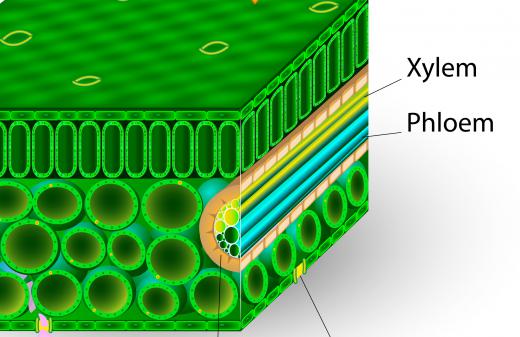What are Some Paleozoic Animals?
 Michael Anissimov
Michael Anissimov
Paleozoic animals lived during the Paleozoic era, a huge stretch of time extending from the beginning of the Cambrian period, 542 million years ago, to the catastrophic Permian-Triassic extinction, about 251 million years ago. The era encompasses six geologic periods, and from youngest to oldest, they are: Cambrian, Ordovician, Silurian, Devonian, Carboniferous, and Permian.
The Paleozoic was a time of extreme evolutionary change and the foundations of life as we know it were set during this period. Immediately prior to the Paleozoic, there were few, if any animals with hard shells, and as far as we know, there were no land plants or animals whatsoever. The largest early Paleozoic animal was probably no more than a few inches in length, as the earlier Ediacaran communities, which consisted of simple frond-like organisms up to a meter or so in length, had mostly died out.

One of the first well known Paleozoic animals, and in fact indicative of the beginning of the entire era, was the familiar trilobite, an extremely numerous arthropod that formed its own class, Trilobita. Trilobites were among the first animals to have hard shells, and their fossils are so numerous that you can buy them today on eBay for $10 US Dollars (USD) or less. Even the earliest trilobites had compound eyes with calcite lenses, a characteristic unique to the group. For the time, this was an impressive evolutionary innovation.
About ten or so million years into the Paleozoic, probably the most significant evolutionary radiation in the history of life occurred — the Cambrian explosion. The Cambrian explosion is given its name because of the geologically sudden appearance of practically all modern phyla, even vertebrates, represented by the first jawless fish, which would be successful for dozens of millions of years, until being replaced by jawed fish in the Ordovician.
Another of the iconic Paleozoic animals are the eurypterids, the sea scorpions, which were career predators for practically the entire Paleozoic era, only becoming extinct at its very ending. These scorpions are the descendants of modern scorpions and some, such as Jaekelopterus, exceeded two meters in length. Though many paleontologists are likely disappointed that eurypterids aren't around to study, most beachgoers would probably prefer they remain extinct.
The Paleozoic saw the evolution of the first terrestrial flora and fauna, which rapidly covered most of the Earth's land area during this period. Land plants evolved from green algae, at first just a few inches tall, until they developed vascular tissues, then they became a few feet tall. After developing true wood, plants could really "let loose," growing many tens of meters tall by the latter part of the Paleozoic. These land plants were joined by many Paleozoic animals that had evolved the ability to walk on land, featuring independent lineages of invertebrates (mostly insects and chelicerates like mites) and vertebrates (fish started to walk on land and became amphibians). By the end of the period, there were so many Paleozoic animals, accompanied by Paleozoic flora, that complex terrestrial ecosystems roughly analogous to those of all future eras were established.
The Paleozoic era came to a close with a catastrophic extinction that wiped out 97% of marine genera and 70% of terrestrial vertebrate genera.
AS FEATURED ON:
AS FEATURED ON:











Discussion Comments
How would those animals of the paleozoic era differ from the ice age animals?
Great article -- I love how you mentioned the anatomy of the animals in the paleozoic eras.
That's a great way to distinguish between the lifeforms of different eras, since, for the most part, they fall very clearly into clearly defined categories, like the vertebrate/invertebrate difference between the older paleozoic and theb cambrian eras.
Nicely written, wisegeek!
Wow. You always hear about people wanting to see animals before their extinction, but I think that I'd have to give the Paleozoic period a pass if there were giant sea scorpions.
I've got enough of a problem with normal, hand-length scorpions, much less giant ones!
I guess I'd have to say I would be in full support of the Paleozoic mass extinction, if it got rid of those monsters!
Post your comments